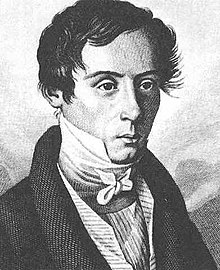Augustin-Jean Fresnel
Augustin-Jean Fresnel | |
|---|---|
 Augustin-Jean Fresnel | |
| Born | May 10, 1788 |
| Died | July 14, 1827 |
| Nationality | French |
| Known for | wave optics |
| Scientific career | |
| Fields | physicist |
Augustin-Jean Fresnel (Template:PronEng fray-NELL in English, IPA: [fʁɛˈnɛl]] in French) (May 10, 1788 – July 14, 1827), was a French physicist who contributed significantly to the establishment of the theory of wave optics. Fresnel studied the behaviour of light both theoretically and experimentally.
Biography
Fresnel was the son of an architect, born at Broglie (Eure). His early progress in learning was slow, and he still could not read when he was eight years old. At thirteen he entered the École Centrale in Caen, and at sixteen and a half the École Polytechnique, where he acquitted himself with distinction. From there he went to the École des Ponts et Chaussées. He served as an engineer successively in the departments of Vendée, Drôme and Ille-et-Vilaine; but having supported the Bourbons in 1814 he lost his appointment on Napoleon's return to power.
On the second restoration of the monarchy, he obtained a post as engineer in Paris, where much of his life from that time was spent. His researches in optics, continued until his death, appear to have begun about the year 1814, when he prepared a paper on the aberration of light, which, however, was not published. In 1818 he wrote a memoir on diffraction for which in the ensuing year he received the prize of the Académie des Sciences at Paris. He was in 1823 unanimously elected a member of the academy, and in 1825 he became a member of the Royal Society of London, which in 1827, at the time of his last illness, awarded him the Rumford Medal. In 1819 he was nominated a commissioner of lighthouses, for which he was the first to construct a special type of lens, now called a Fresnel lens, as substitutes for mirrors. He died of tuberculosis at Ville-d'Avray, near Paris.
His labours in the cause of optical science received during his lifetime only scant public recognition, and some of his papers were not printed by the Académie des Sciences till many years after his death. But as he wrote to Young in 1824: in himself "that sensibility, or that vanity, which people call love of glory" had been blunted. "All the compliments," he says, "that I have received from Arago, Laplace and Biot never gave me so much pleasure as the discovery of a theoretic truth, or the confirmation of a calculation by experiment."
Research
His discoveries and mathematical deductions, building on experimental work by Thomas Young, extended the wave theory of light to a large class of optical phenomena. In 1817, Young had proposed a small transverse component to light, while yet retaining a far larger longitudinal component. Fresnel, by the year 1821, was able to show via mathematical methods that polarization could be explained only if light was entirely transverse, with no longitudinal vibration whatsoever.
His use of two plane mirrors of metal, forming with each other an angle of nearly 180°, allowed him to avoid the diffraction effects caused (by the apertures) in the experiment of F. M. Grimaldi on interference. This allowed him to conclusively account for the phenomenon of interference in accordance with the wave theory.
With François Arago he studied the laws of the interference of polarized rays. He obtained circularly polarized light by means of a rhombus of glass, known as a Fresnel rhomb, having obtuse angles of 126° and acute angles of 54°.
He is perhaps best known as the inventor of the Fresnel lens, first adopted in lighthouses while he was a French commissioner of lighthouses, and found in many applications today.
See also
- Fresnel equations
- Fresnel diffraction
- Fresnel integral
- Fresnel lantern
- Fresnel lens
- Fresnel rhomb
- Fresnel zone
- Fresnel zone plate
- Fresnel number
- Fresnel drag
- Fizeau experiment
- Huygens-Fresnel principle
External link and reference
- O'Connor, John J.; Robertson, Edmund F., "Augustin-Jean Fresnel", MacTutor History of Mathematics Archive, University of St Andrews
- This article incorporates text from a publication now in the public domain: Chisholm, Hugh, ed. (1911). Encyclopædia Britannica (11th ed.). Cambridge University Press.
{{cite encyclopedia}}: Missing or empty|title=(help)
